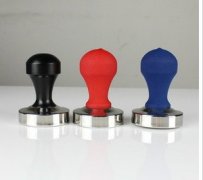What is the basis of boutique barista training? what is Crema?
How did it come about? During the roasting process, a large amount of carbon dioxide is produced in the coffee beans, most of which will be emitted during the cooling process, a few will continue to be kept inside, and the grinding will release these gases, so coffee must be made as soon as possible after grinding.

When hot water hits coffee powder under high pressure, it will emulsify the insoluble oil of coffee powder and dissolve a large amount of carbon dioxide supersaturated, which is much larger than the solubility of hot water under normal pressure. this is why countless small foams immediately appear when the liquid flows from the handle. But this does not fully explain the "Crema", open a can of Coke, we can see countless bubbles coming up, but they simply do not last.
To produce stable bubbles, we need some bubbles and some compounds to "wrap" the bubbles, making the bubble structure stable and elastic. The process of this chemical reaction can be thought of as the role of a surfactant. Unlike milk bubbles, which do this through egg whites, coffee uses a substance called protein melanin. It is produced by a chemical reaction of a group of mixtures during baking. In fact, scientists do not know much about the process. Neither protein nor melanin is hydrophilic, so when hot water strikes, they are naturally distributed on the surface of bubbles, so they can come into contact with more air, resulting in countless small bubbles, so we have-bubbles. There are other things-fat (the author refers to both oil and fat, fat is solid, oil is liquid), the presence of oil often destroys the structure of foam (think about it, when we make a cake, we have to remove the yolk, otherwise the fat in the yolk will lead to the failure of egg whites (that is, quickly stirring egg whites and beating them into milk bubbles).
So will the oil in the coffee cause crema to disappear quickly in a few minutes? The answer is both right and wrong. The surfactant is dissolved in water, and due to the action of gravity, the surfactant of the bubble surface will be pulled off the surface of the foam together with the water, making the foam fragile, robbing elasticity, and then quickly disappearing. The speed at which the foam disappears is related to the speed at which the water is dragged away, but the foam on the surface of a cup of coffee lasts much longer than the foam on the surface of a cup of coffee, because the liquid is much thicker than it is quickly flushed. This is also confirmed by our taste.
Important Notice :
前街咖啡 FrontStreet Coffee has moved to new addredd:
FrontStreet Coffee Address: 315,Donghua East Road,GuangZhou
Tel:020 38364473
- Prev

Barista training basics Why to use Coffee Powder Press
Baristas all know that when using an espresso machine, the hot water brewed has about 9 atmospheric pressure (of course, this is not a fixed value, there are 12 atmospheric pressure or higher), and the pressure is very high, when the water penetrates the coffee cake. the water is inert. What is inertia, that is, water penetrates through the weakest part of the coffee cake, not from the thickest
- Next

5 reasons Starbucks is successful in China
Five reasons Starbucks is successful in China. If any company should have failed in China, it was Starbucks. China has thousands of years of tea drinking history and a strong tea culture. No one ever thought that Chinese people would drink coffee instead of tea. Yet Starbucks has managed to open more than 570 stores since it landed in China 20 years ago,
Related
- What documents do you need to go through to open a coffee shop? coffee shop coffee shop certificate processing process
- How to purchase Coffee beans in small Cafe how to choose a suitable supplier for domestic Coffee supply Company
- How to drink Starbucks Fragrance White Coffee? how to make Australian White Coffee? what Italian coffee beans are recommended?
- The Story of Flora Coffee: the name of Flora Coffee Bean and the implication of the Flowers on Florna Coffee
- How much does a cup of coffee cost? How much is the profit of a cup of coffee? What is the profit of the coffee shop in a year?
- Yunnan small Coffee, known as "fragrant Coffee", introduces the characteristics of Alpine Arabica Coffee producing areas in Yunnan, China
- 2023 latest Starbucks full menu price list how much is a cup of Starbucks coffee what is better to drink the most popular hot and cold drinks recommended
- Starbucks different kinds of Coffee Price list Starbucks menu 2023 Top Ten Best drinks in Starbucks
- Starbucks Spring praise Comprehensive matching Coffee Bean theme Story Packaging implication and taste description
- The cost of a cup of coffee latte American coffee cost price and selling price

